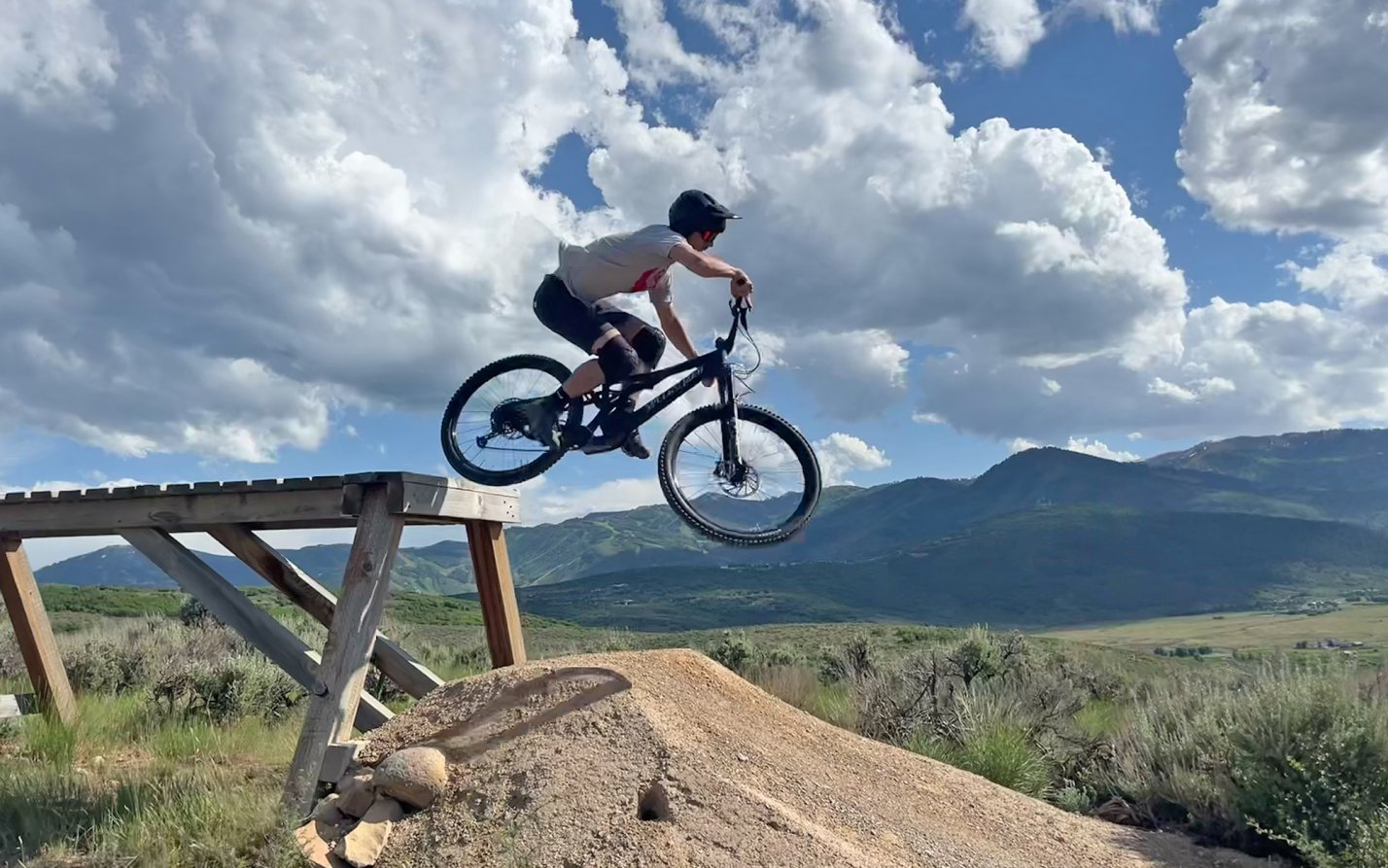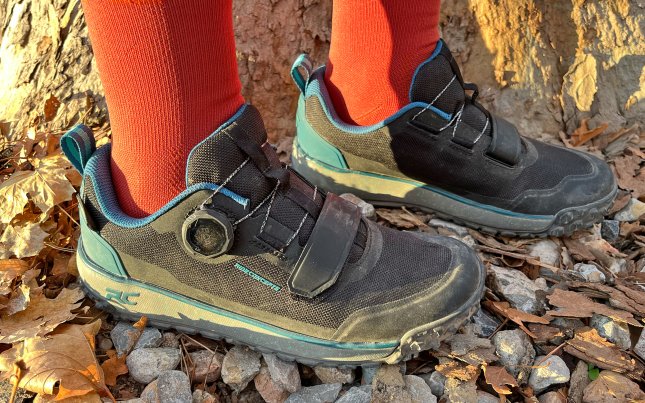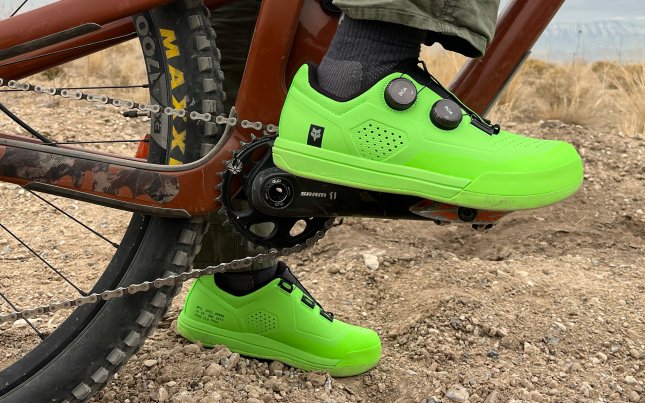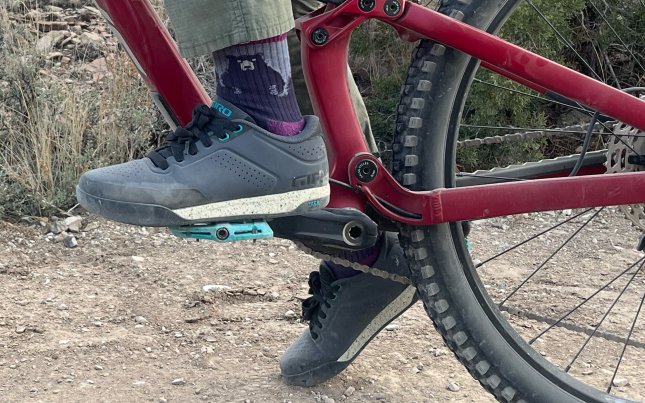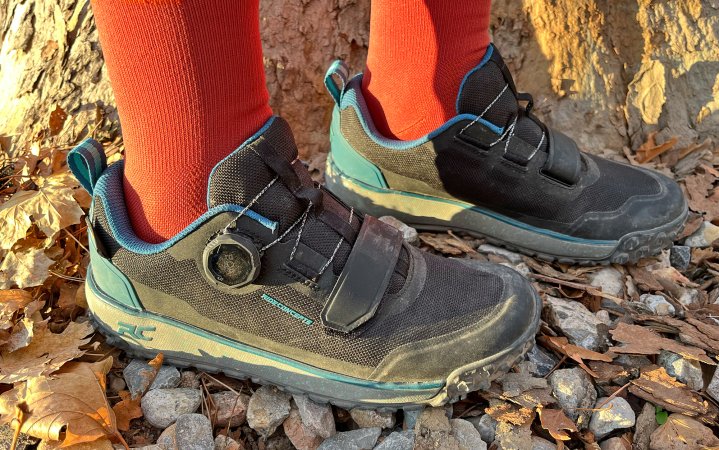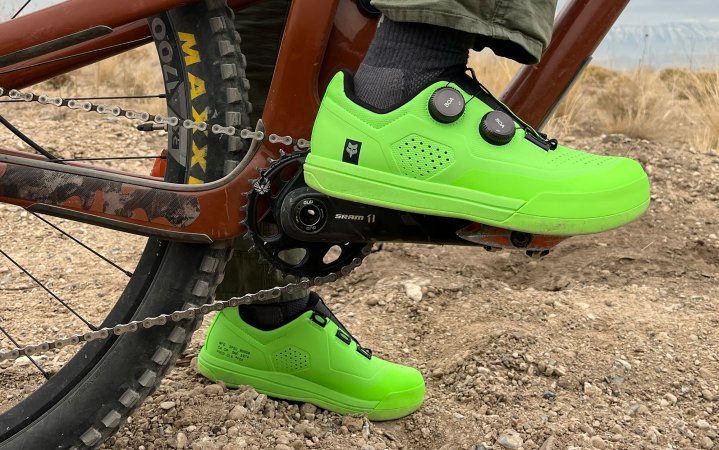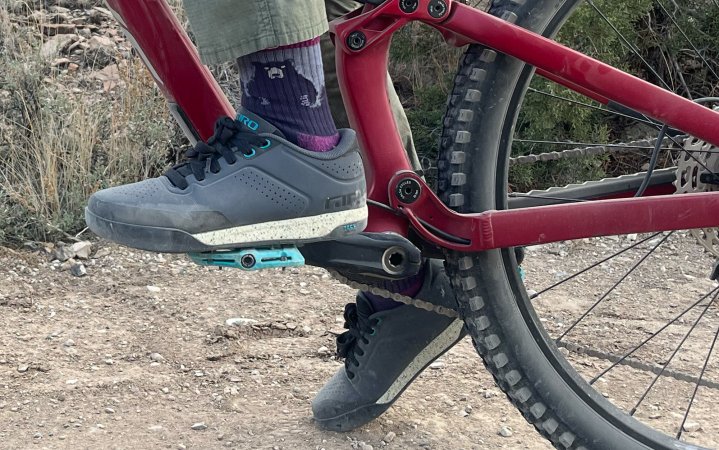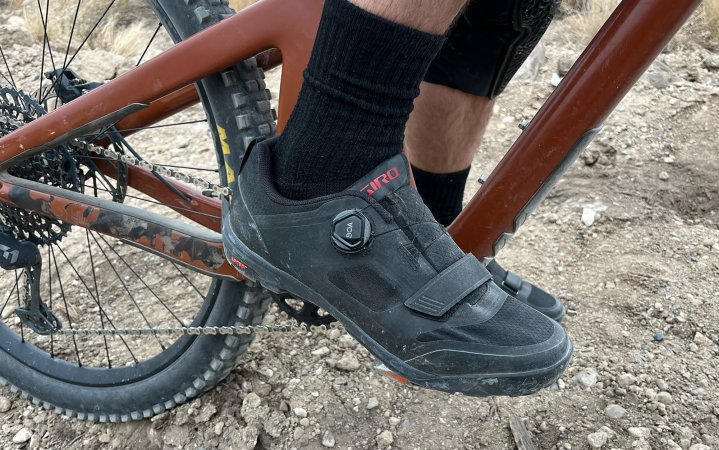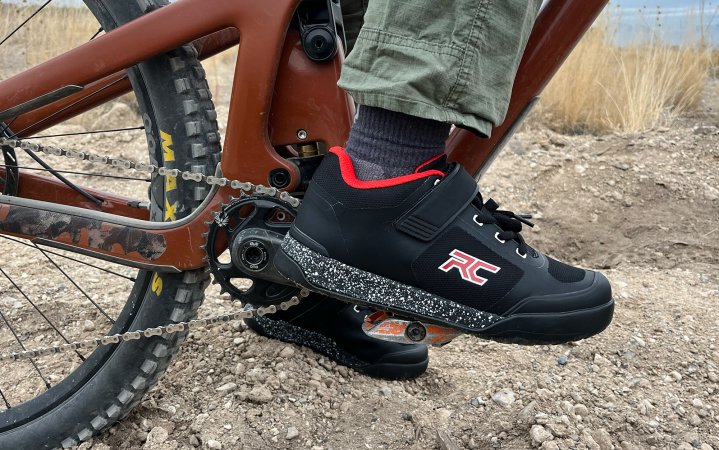We may earn revenue from the products available on this page and participate in affiliate programs. Learn More ›
Plenty of new (or stubborn) bikers wear any old flat soled sneaker to the trailhead. Hell, I met a guy who swears by his cowboy boots at the bike park. When bikes are so expensive, skimping on footwear seems like a no brainer. But slippery shoes are a recipe for a shinner, or worse. For this review my testers and I rode downhill, enduro, park, and trail in clipless and flats to find the best mountain bike shoes for power, protection, and grip.
- Best Flats: Ride Concepts Flume Boa
- Best Clipless: Fox Union Boa
- Best for Beginners: Giro Latch
- Best Clipless Cross Country Hybrid: Giro Ventana
- Best Downhill: Ride Concepts Traverse Clip
How We Tested the Best Mountain Bike Shoes
The first choice you have to make when picking out the best mountain bike shoes is flats or clipless. While clipless sounds as though there shouldn’t be a clip, it’s actually a reference to old-school mountain biking when you’d clip your toe into a basket. There is a clip mechanism in clipless pedals, making the name confusing, but at least we don’t have to tuck our shoes into a cage anymore …
The benefits of clipless shoes are that your feet are always in the right position for maximum power and they can’t slip off at inopportune moments. The downside is it takes some practice to unclip from your bike when you have to bail, or start to fall.
Flat shoes are exactly like they sound with grippy soles that keep your feet on the pedal. I enlisted multiple testers for these reviews to test out both mountain bike shoe varieties. We rode varying terrain in Colorado and Utah to find the best mountain bike shoes for beginners, trail, enduro, and downhill.
Best Mountain Bike Shoes: Reviews & Recommendations
Best Flats: Ride Concepts Flume Boa
Pros
- Boa
- Shock absorbing insole
- Deep lugs
Cons
- High stack height
Key Features
- Weight: 400 grams
- Cordura upper
- Max Grip rubber outsole
- Boa and Velcro closure
There are a ton of clipless shoes out there with Boa closures, but not many flats. I love that I can quickly and easily adjust these shoes without laces getting caught on my pedals. My foot feels secure and powerful with a Velcro strap on the forefoot for added stability.
While most flat mountain bike shoes aim to keep the space between your foot and pedal as low as possible to retain contact, Ride Concepts incorporates a relatively high stack height and heel drop. During testing, I thought this actually reduced fatigue in my feet and calves when pedaling and riding. Though some might prefer a more neutral sole for trail-feel.
In the event you have to hike-a-bike, the outsole has deep toe and heel lugs. I appreciated the extra traction on steep scree and chunky climbs. These are actually pleasant to walk in. There’s anti-abrasion film on the toe, sides, and heel to prevent snags in the Cordua upper. And the shock absorbing insole helped me keep contact with the pedal on rougher terrain.
These are the best mountain bike shoes I’ve used, and as an added perk, I think the odor control technology in the mesh lining actually helps. They’re fast and simple to put on before a climb and snug with good protection on the downhill.
Best Clipless: Fox Union Boa
Pros
- Boa
- Reinforced toe cap
- Great protection for weight
Cons
- Not the most comfortable to walk in
Key Features
- Weight: 443 grams
- Single piece of rubberized TPU upper
- Ultratac outsole
- Dual Boa closure
For those looking to push their skill level and conquer technical terrain, while still maintaining pedal efficiency, you can’t do better than the Fox Union Boas. One life-long biking tester says they’re the best clipless shoes he’s ever worn. Fox uses a single piece of rubberized TPU for the upper, providing a consistent fit that combined with the molded heel cup keeps your foot locked into place.

The stiff and thick TPU provides great protection in a material that’s light enough for long days and big climbs, with ventilation holes for breathability. A nylon shank resides in between a lightly cushioned Eva midsole and durable Ultratac outsole to efficiently transfer power to your pedal.
This aggressive enduro trail shoe is surprisingly lightweight for how intense it is. Riders love the consistent, rigid fit for a powerful do-it-all shoe. It shines on difficult enduro trails when you’re busting your ass uphill for thrill-inducing tech or jump lines. The shallow channels make it so your foot clips in almost flat with larger enduro-style pedals.
Best for Beginners: Giro Latch
Pros
- Easy to adjust foot position
- Neutral sole
- Lightweight protection
Cons
- Not the best tread for hiking or walking
Key Features
- Weight: 334 grams
- Microfiber upper
- Tack Rubber outsole
- Lace closure
I started mountain biking in a borrowed pair of downhill flats from Specialized, and I’ve sent it in trail runners before, too. But the Latches are a huge upgrade. They provide just enough protection for enduro riding with a bit more flex. While the lugs aren’t the deepest and rubber isn’t the grippiest, I felt most confident in my pedal connection in these mountain bike shoes.

The low-profile midsole, Tack Rubber outsole, and relaxed tread allow me to adjust my foot position more easily to ensure a stable riding position. In my beefy downhill flats, I felt locked in wherever my foot happened to land.
Giro advertises the Mute Foam used in their midsole as suspension for your feet. The foam slows rebound, cutting down on chatter that can dislodge your foot. And it actually works. These are a great all-around trail shoe for hard-charging beginners that value foot protection and control.
Read Next: Best Mountain Bikes
Best Clipless Cross Country Hybrid: Giro Ventana
Pros
- Good protection
- Great pedaling efficiency
- Comfortable
Cons
- Best suited for trail or XC pedals
Key Features
- Weight: 417 grams
- One-piece Synchwire upper with PU bonded mesh
- Sensor rubber outsole
- Boa and Velcro closure
“Wow, these fit like a glove,” said one enduro and downhill obsessed tester. Cross country mountain bike shoes are a beast of their own with stiffer construction and different cleat styles. They’re also lightweight, valuing performance over protection because cross country terrain is typically less rowdy. But where they can’t be beat is pedaling efficiency. Giro’s Ventanas are an all-mountain trail shoe with cross country roots, combining pedal power and protection.
While not as gravity oriented like enduro or all-mountain trail shoes, the Ventanas provide a fair amount of protection. The toe and heel are reinforced with rubber, and the upper is stiff, but lightweight. The Eva cushioning provides all day comfort for long days on trail and an integrated shank allows the Ventanas to pedal like a cross country shoe. One tester felt noticeably more efficient on uphills, and still connected every feature on a slope style black diamond in the Ventanas.
The Ventanas shine while on trail, but they have enough beef to tackle techy lines, too. These are an ideal shoe for a trail rider that wants to be protected on the occasional enduro day. Because of the similarities to a true cross country clipless, these will fit best on smaller pedals designed for trail or XC riding. The channel wasn’t a good fit for the beefy enduro pedals we first tried to set them up for.
Best Downhill: Ride Concepts Traverse Clip
Pros
- Mid-height protection
- Reinforced toe and heel
- Wide cleat box
Cons
- Heavy
- Laces
Key Features
- Weight: 475 grams
- Synthetic upper
- Clip Grip rubber outsole
- Lace and Velcro closure
Downhill riding is typically lift accessed, or shuttled. So there shouldn’t be much pedaling involved, which is good because these shoes are effing heavy. What they give in return is a lot of foot protection and a stable riding platform. Plus, they look cool. And let’s face it, if you’re at the downhill park, steez is important.
The Traverse incorporates D30 shock absorbing technology in the insole and inside edge of your foot. Intensely thick custom-molded toe and heel caps protect the front and back. To reduce the likelihood of missing a clip or failing to engage, the cleat box is 40mm wide and easy to access, even with burly downhill pedals.
Similar to the Flumes by Ride Concepts, the stack height and heel drop are significant in these shoes, partly because of the extra D30 padding in the insole to protect your forefoot and heel. This will result in less pedal feel, which depending on your preference can be good or bad.
A PowerDrive shank is what makes the base of these so stiff for an incredibly stable and powerful riding platform. The lugs at the toe and heel deepen for better traction off-bike. If you’re downhill or die, these could be the burly shoes you’re looking for, but don’t expect them to be fun to pedal.
How to Choose the Best Mountain Bike Shoes
Flats vs Clipless
The best mountain bike shoes for you depends on if you want your feet clipped in or not. Flats don’t lock your feet into the pedals, and resemble a skate shoe or sneaker. Clipless shoes actually clip into your pedals and require a twisting motion to release.
Flats
This decision should be an easy one. If you’re new to mountain biking, almost everyone will tell you to start out on flats until you’re comfortable. Flats allow you to remove your foot from the pedal at any time, without having to twist your foot out of a clip-in device. Bailing, stopping, and falling are all easier with flats.
Some other reasons you might want flat mountain biking shoes are for freeriding or jump lines. All of the athletes you see at Redbull Rampage are rocking flats. They’re taking their feet off the pedals constantly to throw tricks or take turns. Also, if you live in a particularly slick environment that can slip your bike easily, or clog your clips with mud, flats could be a better choice.
Clipless
You never have to graduate to clipless pedals if you don’t want to, but they do provide some benefits for experienced riders. You get a more connected bike feel with proven increased pedal efficiency and more power out of turns. Riding steep, techy lines in clips will also keep your feet locked to the pedals so you don’t slip off and get royally messed up on a rock.
Style of Riding
After you decide which style of pedal you want, you can narrow it even further by style of riding. Stiff, lightweight shoes are best for cross country, while a trail shoe might have a wider, more comfortable fit and slightly more protection. Enduro and downhill shoes start to increase protection, but also increase in weight.
Pedal Compatibility
Granted, most flat pedals will work with most flat shoes (or cowboy boots for that matter), getting the correct size flat pedal for your foot will increase the amount of pins in contact with your shoe for better grip. If your pedal is too big, your foot might not cover all the pins, and if your pedal is too small, you’re missing out on more pins.
Clipless pedals are where you start to specialize by riding style. The size and clip mechanism can vary and it’s important to select shoes that are compatible with your pedals. For instance, one tester’s enduro pedals weren’t compatible with the cross country rooted Ventanas, and some shoes like the Ride Concepts Traverse recommend using shims with specific pedal brands. This video breaks down a lot of those differences.

FAQs
When you’re just starting out, you can get away with using Vans, trail runners, or other sneakers. The issue is the pins in your pedals will start to eat away the rubber, giving you less grip and destroying your shoes. That might not sound so bad until you’re barreling downhill and the last thing you want is your foot to slip off the pedal and cause you to crash. Speaking of barreling downhill, the best mountain bike shoes have added protection in the event a rock, stick, or your own pedal hits your foot. Bike shoes are also stiffer with more surface area for a more powerful riding platform.
Flat shoes are great for mountain biking. Clipless shoes will increase your efficiency, but only if you’re comfortable using them.
Ideally, the best mountain bike shoes could last you around three seasons, but it’s important to inspect your shoes for damage after every ride. If the rubber soles start to degrade, they’re only going to get less grippy. If you’re riding clipless, make sure the plastic platform connecting the cleat to your shoe isn’t cracked. Generally, you want the structural integrity of your shoe intact for maximum protection, and a locked in feel.
Final Thoughts
Before you hit the downhill park in your hiking boots, check out some of the best mountain bike shoes. You might be surprised at how hugely they impact your riding experience. We rode a variety of trails in all of these shoes, and feel they’re some of the best options on the market. Check back as we continue to test more shoes and update these reviews with remarks toward durability.
- Best Flats: Ride Concepts Flume Boa
- Best Clipless: Fox Union Boa
- Best for Beginners: Giro Latch
- Best Clip-Pedal Trail Shoe: Giro Ventana
- Best Downhill: Ride Concepts Traverse Clip
